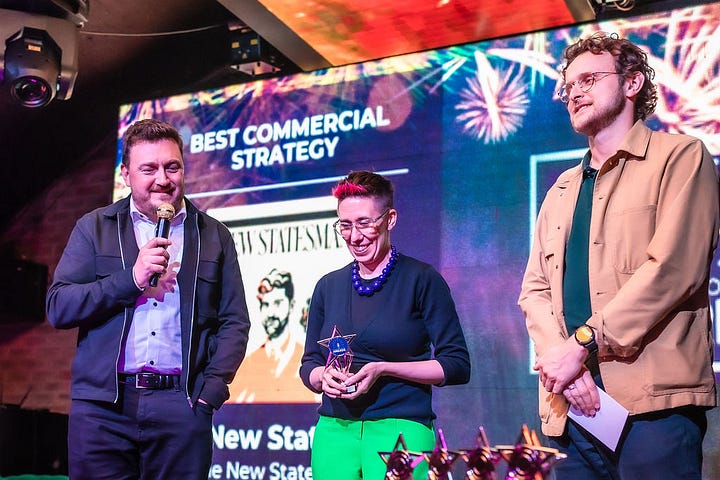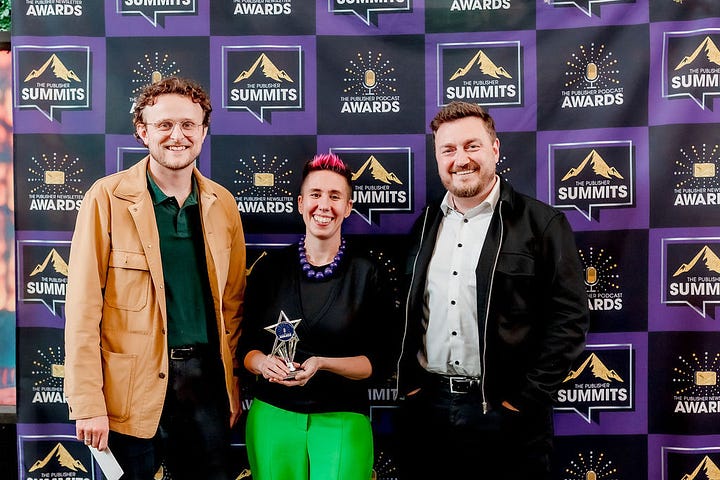Let’s be honest, there’s a lot of nonsense AI guff flying around at the moment, isn’t there?
I’ve seen some strong - and growing - pushback recently to the idea of using AI to create content. And, mostly, I agree with the sentiment.
But I’m generally quite an optimist when it comes to new technologies. So I’ve been experimenting with tools and techniques powered by AI to help improve my podcast production workflows.
Some I’ve abandoned as soon as I’ve started - like I said, a lot of guff - but there are several tools which have genuinely transformed my workflows and saved me hours of labour.
These are generally cheap or even free to use, and with careful human management can be more Wall.E and less HAL.
Here we go…
The AI tools I actually use to make podcasts.
1. Gemini Deep Research
A few weeks ago I needed to produce this podcast episode about the life and work of JMW Turner.
One problem: I knew nothing about the life and work of JMW Turner.
That’s not uncommon - we often have to learn fast to produce shows on something we didn’t have prior knowledge of.
But I was short on time. My usual method of research (Google, read, follow the breadcrumbs, compile notes, review notes, draft script) was going to take too long. So I turned to Gemini.
Within 10 minutes Gemini Deep Research had compiled a briefing document that gave me the salient points I needed to know, based on a custom research brief I’d provided outlining the main areas of interest. It provided citations and links to the sources it used so I could check accuracy and read more information for myself. This directly informed the script I wrote, and provided me with a jumping off point to structure the interview.
It helped me do half a day’s research in just a few minutes.
What is it?
Gemini is Google’s free to access LLM chatbot. Deep Research is a mode within Gemini.
Why it’s helpful
Gemini Deep Research mode searches the internet for you, compiling information into a research report. The report is arranged into sections, provides linked citations, and gives you a list of all the websites referenced.
How to use it
Head to gemini.google.com, and select the Deep Research mode.
Enter your prompt telling it what you are researching and why. Include in your prompt any specific areas of interest, or particular outcomes you are looking for.
It will first compile a research plan based on your prompt. Read through this to make sure it’s planning to do what you need. You can edit the research plan if needed.
When you’re happy with the plan, hit Submit and let it do its thing. It’ll take a few minutes to run the research plan and compile the report.
When it returns the report you can read it right in Gemini, export it as a document, or trigger an audio overview so you can listen to a “podcast” about the report findings.
2. NotebookLM
Last week I presented my first ever keynote speech, at the Publisher Podcast Summit in London. (Yes, that is a humblebrag, sorry not sorry).
I’ve come to see the speechwriting process as very similar to preparing a podcast script. And notebookLM is my scriptwriting super-sidekick.
Over the last year or so I’ve been compiling a collection of industry reports. Any time there is a new piece of podcast research released, I grab the PDF and add it to a NotebookLM notebook.
This means I now have a large library of reports and statistics to draw from - and NotebookLM allows me to interact with this library in a simple chat.
In the talk I presented this week, I wanted to reference how many people listen to podcasts in the UK. The latest Edison Infinite Dial UK report is in my Notebook, so I asked “how many people in the uk listen to podcasts?” - and it gave me the answer.
It also gets more nuanced. With a large corpus of information, it can draw out contradictions or comparisons between different reports.
Honestly, I use this all the time, and now Google have finally released a NotebookLM app I can see it getting more and more useful as time goes on.
What is it?
Google’s amazing research and learning assistant, letting you interrogate pdfs, videos, audio files and documents in an LLM chatbot.
Why it’s helpful
NotebookLM lets you your own archive of material, and provides multiple different ways of getting the information into your brain. Ask simple questions in the chat, compile briefings or create audio overviews.
How to use it
Head to NotebookLM.google.com and sign in with your Google account.
Create a notebook and hit the plus button to add a new source.
Once you’ve added sources, use the chat box to give prompts and ask questions.
3. Descript
Although I started editing on Final Cut Pro, I’ve been an Adobe man for the last decade or so. For podcasts, that means Adobe Audition has been my DAW of choice.
When Descript came on the scene a few years ago I was initially resistant. Now I wouldn’t edit without it.
The key feature is the ability to transcribe speech to text, then edit the audio directly from the transcript. But over time they’ve added loads of clever features including Studio Sound to digitally clean up audio, quick and easy video editing, and now the ability to record remote video and audio directly into the editor.
Personally I don’t use every feature and find the package somewhat bloated. But after a bit of practice I find the edit-from-transcript tool the absolute fastest way to cut audio. I also regularly use the Studio Sound feature, but there is one tool for this which is even better (read on for that).
What is it?
Simply the best audio to text transcription and editing tool, with an absolute ton of additional AI-powered features (some of which are useful, some not so much).
Why it’s helpful
In one subscription you get an entire suite of production tools to record, edit and publish both video and audio podcasts.
How to use it
Head to Descript.com and sign up for a free trial. Use their comprehensive learning documentation to get started.
4. Auphonic
Obviously you always record your podcasts in optimal conditions: a treated studio with professional equipment and perfect mic technique.
No?
Me neither.
Sometimes remote podcasts are recorded using weak headphone mics, or you had to record in a room full of echo and background noise.
For a long time I cleaned audio using Descript’s Studio Sound (above). Then I discovered Auphonic.
Descript performs well, but there is some noise it just can’t handle. Echoey audio can come out muddy, or processing to eliminate background noise can leave words clipped or garbled.
For serious treatment, Auphonic is the best free tool I’ve found. It provides options for eliminating different types of sounds, and even to leave some sound types in. By playing with the different settings you can normally get a very clean result.
What is it?
The best free digital audio cleaner I’ve found.
Why it’s helpful
Auphonic takes poor-quality audio and applies AI-powered digital processing to return clean audio that sounds like it was recorded in a studio.
How to use it
Head to Auphonic.com
Drag your audio file onto the box
Create a log in or sign in with your Google account to process up to two hours of audio for free.
5. AutoPod
I must have spent weeks (maybe months?) of my life vision-mixing podcast episodes in Adobe Premier. If you don’t have the luxury of a live vision mixer, a video podcast edit involves bringing all your camera files into an editing system, lining them up and cutting between them to create the edit. This can take at least twice as long as the recording itself, often more.
For a 30 minute podcast episode you’re looking at 1-4 hours of work.
AutoPod does it in 30 seconds.
It does it by reading the audio tracks to determine which person is speaking, and cuts to the relevant camera in time with the audio.
When I first tried it for myself, it was one of the most astonishing things I’d ever seen.
Now, AutoPod is a staple of my workflow. Every single video podcast I edit is vision-mixed using AutoPod, saving me literally hours of work per edit.
Full disclosure: I understand Descript (above) now offers automatic vision mixing too, although I haven’t had a chance to test that out yet.
What is it?
Automated video podcast vision mixer which cuts between cameras based on who is speaking.
Why it’s helpful
Saves literally hours in the edit!
How to use it
Head to autopod.fm to start a free trial.
Download the plugin and install in Adobe Premiere Pro.
Log in using the username and password you set up for your trial.
Find the Autopod plugin in the menu Windows > Extensions
Line up your video and audio files, assign the tracks in the AutoPod extension window, and hit Go.
Time is running out to sign up to the Podcast Crew waitlist.
We’re building a platform to make hiring podcast professionals - and finding work - easier for everyone. Early sign ups will be the first to know when we launch, and enjoy exclusive discounts.
👉 Join the waitlist now at podcastcrew.co.uk
Awards, speeches and podcast community
As I mentioned above, this week I attended the Publisher Podcast Summit and Awards, where it was my honour and pleasure to present the opening keynote, titled the hidden power of podcasts for publishers.
It was also an honour to collect two awards for the New Statesman (where I lead the podcast and video team) for Best Culture Podcast and Best Commercial Strategy. I especially enjoyed collecting the latter with video producer Rob Le Mare, and Suze Cooper who produces the New Statesman’s partner podcasts - and is also a founding member of this newsletter!


But by far the greatest pleasure was meeting several readers of Podcast Strategy Weekly, who said some very kind things about the value they get from receiving the newsletter. Honestly, I’m sort of blown away every time that happens - so thank you!
Founding members
Podcast Strategy Weekly is free to read for up to three issues per month. I’ve also opened a paid subscriber tier offering access to all issues, the entire archive and access to new tools and templates as I develop them.
I also offer the opportunity to get your name, link and message in front of the Podcast Strategy community every week, with a Founding Member subscription. The brilliant people below have done exactly that, and you should definitely check them out.
Suze Cooper, freelance audio journalist supporting publishers, news rooms and media outlets. Find out more.
Jeremy Enns from Podcast Marketing Academy: providing unreasonably detailed podcast marketing strategy to attract & convert buyers. Read more.
Simon Elliot, Crowdfindervideo. Grow and engage your audience with a video podcast. Find out more.
Podschool. Want to start your own podcast? Launch faster and sound better with this step-by-step online course. Get started today.
School of Podcasting. Want to start or grow a podcast? This is where you begin. Start learning.
Want your name in front of 750+ podcast industry leaders - and access to member-only issues of Podcast Strategy Weekly? Become a founding member now.
That’s it for this week.
Let me know what you’d like me to write about next by replying to this email or leaving a comment on Substack.
Have a great week, and see you next Monday!
Chris






Adding AutoPod to my list to try for sure! That’ll be a game changer for some of my clients.
I'll be giving NotebookLM a try!